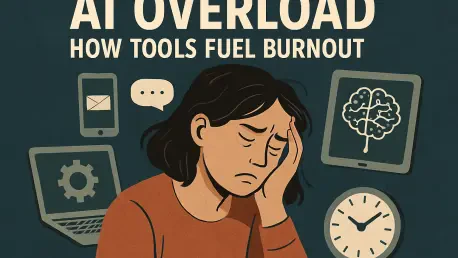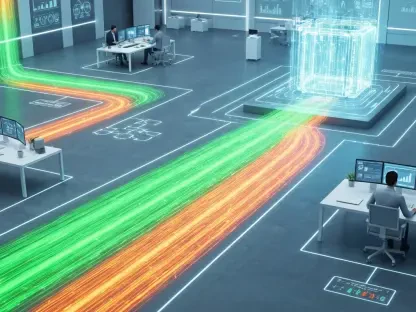Imagine a workplace where artificial intelligence (AI) was promised to be the ultimate game-changer, streamlining tasks and boosting efficiency, only to leave employees more stressed and error-prone than ever before. Across industries, from tech hubs to manufacturing floors, the rapid integration of AI tools has sparked a troubling paradox. Instead of alleviating burdens, these technologies often pile on new pressures, contributing to mental fatigue and diminishing the quality of work. Reports from industry experts and recent studies paint a stark picture: while AI holds immense potential, its unchecked adoption is creating a silent epidemic of burnout and mistakes. This discussion delves into the unintended consequences of AI in professional settings, exploring why tools designed to simplify life are instead complicating it. By examining the cognitive demands, empirical evidence, and potential solutions, a clearer understanding emerges of how to balance innovation with human well-being for sustainable progress.
The Hidden Weight of AI on Workloads
The allure of AI lies in its promise to automate mundane tasks, freeing up time for strategic thinking, yet the reality often tells a different story of increased cognitive strain. Employees are finding themselves saddled with unexpected responsibilities, such as crafting detailed prompts for AI systems, double-checking outputs for accuracy, and weaving these tools into already complex workflows. Far from saving time, these additional steps can erode any anticipated efficiency gains, leaving workers mentally drained by the end of the day. Industry insights suggest that the constant need to adapt to evolving AI interfaces adds another layer of stress, as staff struggle to keep pace with technology that changes faster than their ability to master it. This relentless cycle of learning and verifying transforms what should be a helpful tool into a source of frustration, pushing many toward exhaustion rather than empowerment.
Beyond the added tasks, AI often shifts the nature of work from repetitive to high-stakes decision-making, stripping away crucial mental downtime. Where employees once had moments of respite during routine duties, they now face a barrage of complex problem-solving prompted by AI-generated insights or errors. This shift, while potentially enriching in theory, deprives workers of necessary breaks, heightening the risk of burnout. Reports indicate that the brain, under constant pressure to analyze and correct AI outputs, struggles to recharge, leading to diminished focus over time. The irony is clear: tools meant to lighten the load end up intensifying it, as the human mind grapples with an unyielding stream of demands. This dynamic underscores a critical oversight in AI deployment—failing to account for the human capacity to sustain such intense engagement without adequate support or boundaries.
Evidence of AI’s Toll on Performance
Empirical data reveals a sobering truth about AI’s impact, showing that it can hinder performance just as often as it helps. Studies focusing on software developers, for instance, highlight how AI-generated code often requires extensive debugging, slowing down task completion and introducing more errors than manual methods. This not only frustrates workers but also undermines the very efficiency AI is supposed to deliver. The numbers paint a grim picture, with some analyses indicating that productivity gains are nominal at best when weighed against the time spent correcting mistakes. Such findings challenge the narrative of AI as a flawless enhancer, exposing a gap between hype and reality that companies must address to prevent further dips in output quality. The lesson here is that technology cannot replace the nuanced judgment of human expertise, especially in precision-driven fields.
Further research ties heavy reliance on AI to elevated burnout rates, even when productivity appears to improve on paper. The psychological toll of adapting to these tools, coupled with fears of being replaced by automation, creates a pervasive sense of unease among workers. Stress from constant learning curves and the pressure to integrate AI seamlessly into daily tasks compounds this issue, leaving employees feeling overwhelmed rather than supported. Studies emphasize that the mental energy required to navigate these systems often outweighs the benefits, particularly when training and guidance are lacking. This evidence points to a broader concern: without addressing the human factors behind AI adoption, organizations risk fostering environments where stress and errors flourish, ultimately sabotaging the potential for genuine progress.
Balancing AI’s Promise with Practical Solutions
Despite the challenges, there remains optimism about AI’s capacity to transform workplaces if integrated thoughtfully. Industry thought leaders argue that AI can elevate skills, turning employees into more capable contributors, provided the rollout prioritizes human needs over blind efficiency. This vision hinges on careful implementation, ensuring that workers are not overwhelmed by the technology but instead use it as a partner in their roles. Suggestions include setting clear boundaries on AI usage, such as designated times for interaction, to prevent it from dominating every aspect of work. Additionally, viewing AI as a collaborator rather than a replacement for human effort helps maintain a sense of control, reducing anxiety about obsolescence. These strategies signal a shift toward a more balanced approach, where technology supports rather than dictates the pace of work.
Practical measures to curb AI-induced stress also focus on comprehensive training and realistic expectations. Equipping employees with the skills to navigate these tools confidently can alleviate much of the adaptation stress that fuels burnout. Reports advocate for tailored programs that teach not just how to use AI, but how to critically assess its outputs, ensuring errors are caught early. Moreover, organizations are encouraged to temper their ambitions for AI, recognizing that it is not a cure-all but a tool with limitations. In sectors like manufacturing, where AI enhances safety and efficiency, success stories emerge from this human-centric focus, proving that thoughtful design matters. By investing in support systems and fostering resilience through targeted learning, companies can harness AI’s strengths while safeguarding employee well-being, paving the way for sustainable gains.
Rethinking Technology for Human-Centered Progress
Reflecting on the journey of AI in workplaces, it becomes evident that the initial excitement often masked deeper challenges, as tools meant to simplify tasks instead amplified stress and errors. The past revealed a critical disconnect between intention and outcome, with many employees grappling with cognitive overload while productivity gains remained elusive. Burnout emerged as a silent consequence, driven by relentless demands and insufficient support, underscoring the need for a recalibration of how technology is deployed. Looking back, the evidence was clear: unchecked reliance on AI had fostered environments where human limits were overlooked, leading to diminished performance across sectors.
Moving forward, the focus must shift to actionable steps that prioritize balance over blind adoption. Companies should invest in robust training frameworks, ensuring workers feel equipped rather than overwhelmed by AI systems. Setting limits on usage and fostering a culture of collaboration between human and machine can further mitigate strain. As industries evolve, maintaining a dialogue about realistic expectations will be key to preventing past missteps, guiding AI integration toward a future where well-being and efficiency coexist harmoniously.









